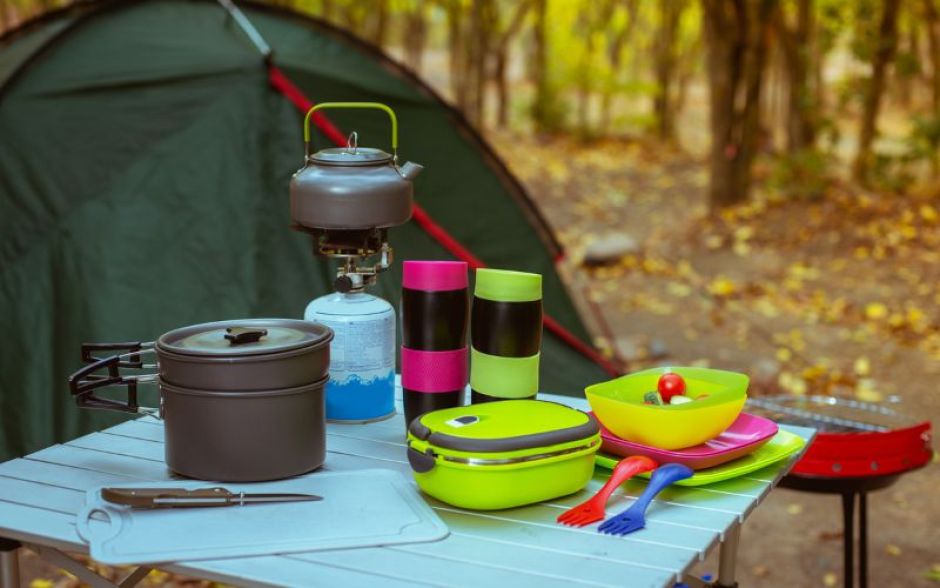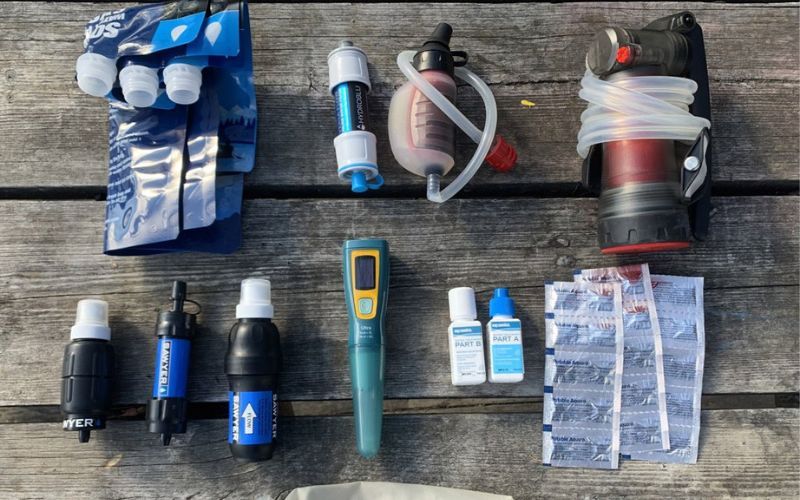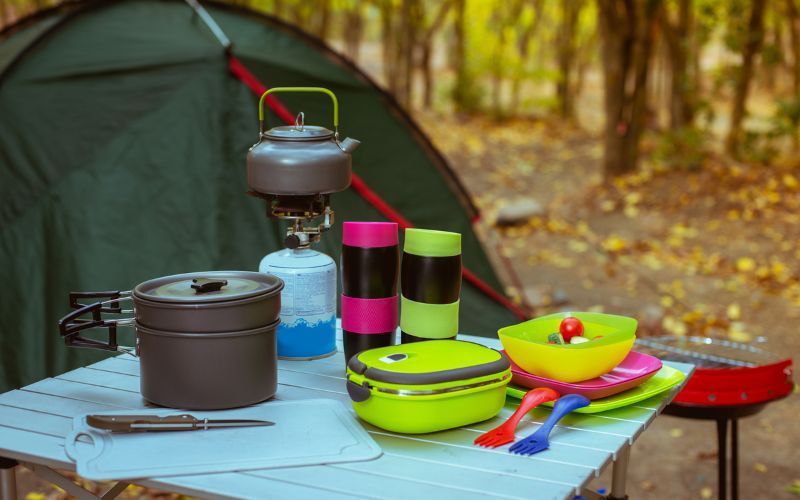
Cooking Gear : Essential Tools for Super Culinary Success in the Great Outdoors 2023
Cooking Gear – Cooking outdoors, whether in the wilderness, while camping, or even in your backyard, is a rewarding and flavorful experience. To elevate your outdoor cooking game, you need the right tools. This article delves deep into the world of Cooking Gear, a sub-category of Nutrition & Hydration that often goes overlooked but plays a pivotal role in ensuring delicious and nutritious meals while on your outdoor adventures.
From portable stoves to versatile cookware, we’ll explore the must-have equipment that transforms the art of outdoor cooking into a culinary delight. Whether you’re a seasoned outdoor chef or just starting your journey, Cooking Gear is the keyword to remember for enhancing your outdoor dining experience.

Table of Contents – Cooking Gear
Choosing the Right Camp Stove – Cooking Gear
Selecting the right camp stove is a crucial decision for any outdoor cooking enthusiast. It’s the cornerstone of your outdoor kitchen and Cooking Gear, and your choice will significantly impact your culinary adventures. Let’s delve deeper into the considerations and options when it comes to choosing the perfect camp stove for your outdoor escapades.
1. Types of Camp Stoves
Camp stoves come in various types, each designed for specific purposes and suited to different outdoor scenarios. Understanding the distinctions between these types is essential to make an informed choice:
- Portable Gas Stoves: These are the most common and versatile camp stoves. They run on propane or butane gas canisters and provide precise temperature control. Portable gas stoves are known for their ease of use, quick setup, and ability to handle various cooking styles. They are perfect for car camping, picnicking, and family outings. Some models even have two burners, allowing you to cook multiple dishes simultaneously.
- Backpacking Stoves: If you’re an ultralight backpacker or minimalist hiker, a backpacking stove is your go-to choice. These stoves are compact, lightweight, and designed for single-serving cooking. They often use canister fuel, alcohol, or solid fuel tablets. While they lack the cooking power of larger stoves, they excel in portability and efficiency. Backpacking stoves are ideal for solo adventurers or small groups looking to shave weight from their gear.
- Campfires: For those who relish the ambiance and flavor of cooking over an open flame, campfires are the way to go. Traditional campfires require some basic fire-building skills and a reliable source of firewood. They offer a rustic, authentic outdoor cooking experience and are perfect for roasting marshmallows, cooking skewers, or preparing foil packet meals. However, campfires are not always practical in areas with fire restrictions, and they require careful management to prevent wildfires.

2. Fuel Types
Once you’ve identified the type of camp stove that suits your needs, it’s essential to consider the fuel source. Different stoves use various fuel types, each with its advantages and considerations:
- Propane/Butane Canisters: These gas canisters are widely available and easy to use. They provide consistent heat and are suitable for a range of temperatures. However, they can be heavy and bulky for extended trips, and it’s essential to carry extra canisters if you’ll be cooking for an extended period.
- Liquid Fuel: Liquid fuel stoves, such as white gas or kerosene stoves, are renowned for their reliability and performance in extreme conditions, including cold weather and high altitudes. They are often used for mountaineering expeditions and long-term camping. However, they require priming, maintenance, and careful handling of fuel, which may be less convenient for beginners.
- Alcohol Stoves: Alcohol stoves, typically using denatured alcohol, are favored by ultralight backpackers for their simplicity and lightweight design. They are easy to refill, but their fuel can be less efficient in cold weather. Alcohol stoves are best suited for solo hikers and those who prioritize minimalism.
- Solid Fuel Tablets: These compact tablets are ideal for ultralight backpacking and emergency situations. They burn cleanly and are simple to use. However, they may have limited cooking power and longer boil times compared to other fuel sources.
3. Cooking Style and Features
Consider your preferred cooking style for your Cooking Gear and the features you desire in a camp stove:
- Simmer Control: If you enjoy simmering sauces, soups, or delicate dishes, look for a camp stove with adjustable flame control. Not all stoves offer this feature, so check product specifications carefully.
- Boil Time: Boiling water quickly can be essential for efficiency in the wilderness. Check the stove’s boil time for a specific quantity of water to ensure it meets your needs.
- Wind Resistance: Wind can significantly affect a stove’s performance. Some stoves come with windshields or integrated wind protection to maintain a steady flame in adverse conditions.
- Ignition: While some stoves require manual ignition using matches or a lighter, others feature piezo-electric ignition systems for quick and hassle-free lighting.
- Weight and Size: If you’re concerned about weight, pay attention to the stove’s dimensions and weight. Backpackers often prioritize compact, lightweight stoves, while car campers may prioritize cooking power over portability.

4. Safety and Regulations
Before purchasing a camp stove / Cooking Gear, familiarize yourself with local regulations and restrictions regarding open flames and camp stoves in the areas you plan to visit. Some regions may have fire bans or restrictions on specific types of stoves, such as alcohol stoves. Compliance with these regulations is essential for both safety and environmental conservation.
5. Budget and Durability
Cooking Gear come in a wide range of price points, so it’s essential to establish your budget beforehand. While it’s tempting to opt for the cheapest option, investing in a high-quality Cooking Gear can pay off in the long run. Durable materials, robust construction, and reliable performance should be priorities when choosing a stove that will accompany you on many outdoor adventures.
In conclusion, choosing the right Cooking Gear is a significant decision for outdoor enthusiasts. Your selection should align with your cooking needs, preferences, and the specific conditions you’ll encounter in the great outdoors. With the right camp stove in your gear arsenal, you’ll not only enjoy hot, delicious meals in the wilderness but also enhance your overall outdoor cooking experience. Whether you’re a backpacker seeking the perfect ultralight option or a camper aiming for gourmet meals under the open sky, your camp stove is the key to culinary success in the outdoors.
Essential Cookware and Utensils – Cooking Gear

Cookware and utensils are the unsung heroes of outdoor cooking, enabling you to transform raw ingredients into culinary delights amidst the beauty of nature. Choosing the right cookware and utensils is paramount to ensure that your outdoor meals are not only delicious but also practical to prepare. In this section, we’ll explore the must-have essentials that will elevate your outdoor cooking experience.
1. Camping Cookware Sets
A reliable camping Cooking Gear set is the backbone of your outdoor kitchen. These sets often include a variety of pots, pans, and lids that nest together for compact storage. Look for the following features when selecting a camping Cooking Gear set:
- Non-Stick Coating: Non-stick Cooking Gear makes cooking and cleaning a breeze, even in the wilderness. It prevents food from sticking to the surface and reduces the need for excessive oil or butter.
- Material: Camping Cooking Gear is typically made from aluminum or stainless steel. Aluminum is lightweight and heats up quickly, while stainless steel is durable and resistant to rust. Choose the material that best suits your needs and preferences.
- Lids: Lids help retain heat and speed up cooking times. Some lids may have built-in strainers, which are handy for draining pasta or vegetables.
- Handles: Foldable or removable handles are a space-saving feature. They allow you to nest the cookware pieces together neatly. Insulated handles or grips prevent burns when handling hot cookware.

2. Portable Griddles and Grills
For those who relish the taste of grilled food in the great outdoors, portable griddles and grills are essential additions to your cookware collection. They come in various sizes and configurations, including:
- Grill Grates: These are designed to be placed over an open flame or on a campfire grate. They create distinctive grill marks and can accommodate a variety of foods, from steaks to vegetables.
- Portable Grills: These are self-contained grilling units with legs that provide a stable cooking surface. They often come with adjustable grates to control the distance between the food and the heat source.
- Griddle Pans: Griddle pans have a flat cooking surface that’s ideal for pancakes, burgers, and breakfast items. They often have a non-stick coating for easy flipping and cleaning.
3. Utensils for Outdoor Cooking
Outdoor cooking requires a basic set of utensils to prepare, cook, and serve your meals. Consider packing the following utensils in your outdoor kitchen kit:
- Spatula: A spatula is essential for flipping pancakes, burgers, and delicate items like fish fillets. Look for one with a long handle to keep your hands away from the heat.
- Tongs: Tongs are versatile and handy for turning food on a grill, flipping items in a pan, or even serving salad. Opt for tongs with a locking mechanism for easy storage.
- Ladle: A ladle is useful for serving soups, stews, and sauces. Look for a lightweight, heat-resistant ladle that won’t add unnecessary weight to your gear.
- Cooking Spoon: A sturdy cooking spoon with a long handle is great for stirring and serving. Some models come with a slotted design for draining liquids.
- Knife and Cutting Board: While you don’t need a full kitchen knife set, a sharp, multipurpose knife and a compact cutting board are essential for food preparation.
- Can Opener: If your meal plans involve canned ingredients, a portable can opener is a must. Choose one that’s compact and easy to use.
- Pot Grips: Pot grips or handle covers are crucial for safely handling hot cookware. They prevent burns and make it easier to move pots and pans.
4. Compact Coffee and Tea Equipment
For caffeine enthusiasts and those who appreciate a warm beverage in the morning or evening, compact coffee and tea equipment is a delightful addition to your outdoor cooking gear. Look for items like:
- Camping Coffee Maker: Portable coffee makers, such as French presses or pour-over devices, allow you to enjoy freshly brewed coffee even in remote locations.
- Tea Infuser: A compact tea infuser or strainer is perfect for steeping your favorite loose-leaf teas while camping or hiking.
- Mugs or Insulated Tumblers: Choose lightweight, insulated mugs or tumblers to keep your coffee or tea hot and your cold beverages cold.
5. Pot Grips and Cleaning Supplies
In addition to the essential cookware and utensils, consider adding the following items to ensure a smooth and safe outdoor cooking experience:
- Pot Grips: Pot grips or handle covers are crucial for safely handling hot cookware. They prevent burns and make it easier to move pots and pans.
- Dishwashing Kit: A compact dishwashing kit should include biodegradable soap, a scrubbing pad, and a collapsible basin or sink for cleaning cookware and utensils.
- Dish Towels and Dishcloths: Lightweight and quick-drying dish towels and cloths are handy for drying cookware and wiping down surfaces.
- Collapsible Water Container: A collapsible water container is useful for storing water for cooking, cleaning, and drinking. Look for a design that saves space when not in use.
In conclusion, assembling the right cookware and utensils for outdoor cooking is essential for ensuring that your meals in the wilderness are not only delicious but also manageable to prepare. A well-equipped outdoor kitchen makes it possible to enjoy a wide range of culinary delights while camping, hiking, or simply spending time in the great outdoors. By selecting durable, versatile, and space-saving cookware and utensils, you can savor the joys of outdoor cooking and create memorable meals amid the beauty of nature.
Fuel and Fire Starters – Cooking Gear
Fuel and fire starters are the lifeblood of outdoor cooking, ensuring you have the means to prepare hot, delicious meals amidst the natural beauty of the outdoors. Choosing the right fuel source and fire-starting methods can significantly impact your cooking experience. In this section, we’ll explore various fuel options and the essential fire-starting tools to keep your outdoor culinary adventures ablaze.
1. Fuel Options
Selecting the appropriate fuel for your camp stove or outdoor cooking setup is a pivotal decision. Different fuels have their unique characteristics and are suitable for various conditions and cooking styles. Here are some common fuel options:
- Propane and Butane Canisters: Propane and butane canisters are popular fuel sources for portable gas stoves. They offer quick and convenient ignition and are ideal for car camping, picnicking, and family outings. Canister fuels provide precise temperature control and are suitable for a wide range of temperatures. They are relatively easy to find and readily available in outdoor stores and campgrounds.
- Liquid Fuel (White Gas and Kerosene): Liquid fuels, such as white gas (also known as Coleman fuel) and kerosene, are renowned for their reliability and performance in extreme conditions, including cold weather and high altitudes. They are often used for mountaineering expeditions and extended camping trips. Liquid fuel stoves require priming, and handling the fuel can be more involved and less convenient for beginners. However, their versatility and ability to perform in challenging environments make them a top choice for serious outdoor enthusiasts.
- Alcohol: Alcohol stoves, which typically use denatured alcohol, are favored by ultralight backpackers and minimalist hikers. They are known for their simplicity, lightweight design, and ease of use. Alcohol stoves are efficient for heating water and are ideal for solo adventurers or small groups who prioritize minimalism. However, alcohol stoves may have limitations in cold weather and can be slower to boil water compared to other fuel sources.
- Solid Fuel Tablets: Solid fuel tablets are compact and lightweight, making them a convenient option for ultralight backpacking and emergency situations. They burn cleanly and are easy to ignite. Solid fuel tablets are efficient for heating water and basic cooking needs. However, they may have limited cooking power and longer boil times compared to liquid or gas fuels.
2. Fire Starters
Once you’ve chosen your fuel source, you’ll need reliable fire starters to ignite your camp stove or create a fire for campfire cooking. Fire-starting methods can vary, so it’s essential to have the right tools on hand:
- Waterproof Matches: Waterproof matches are a reliable and straightforward fire-starting tool. They are designed to light even when wet, making them suitable for rainy or humid conditions. Store them in a waterproof container to ensure they remain dry in your outdoor gear.
- Lighters: Disposable lighters and refillable butane lighters are popular fire-starting tools. They are compact, easy to use, and readily available. Consider carrying multiple lighters as backup, as they can run out of fuel.
- Fire Starter Kits: Fire starter kits often include waterproof matches, a fire striker, and fire starter sticks or tinder. These kits provide multiple fire-starting methods in one package, ensuring you have options for different situations.
- Fire Striker: A fire striker or ferrocerium rod produces sparks when struck with a metal blade. This method is reliable in various weather conditions and can be used repeatedly. It’s an excellent backup option for lighting fires.
- Tinder: Tinder is the initial fuel you use to ignite a fire. It can be natural materials like dry leaves, twigs, or birch bark, or commercially available fire starter sticks or cotton balls soaked in petroleum jelly. Having a source of tinder readily available can expedite the fire-starting process.
- Fire Starter Cubes: Fire starter cubes are compact, pre-packaged fuel sources that ignite quickly and burn consistently. They are ideal for campfires and can be used in conjunction with tinder to build a fire.
3. Safety and Environmental Considerations
When handling fuel and fire starters in the outdoors, safety and environmental responsibility are paramount. Here are some essential tips to keep in mind:
- Follow Local Regulations: Familiarize yourself with local regulations and restrictions regarding open flames and campfires in the areas you plan to visit. Some regions may have fire bans or restrictions on specific types of stoves and fuels.
- Leave No Trace: Adhere to Leave No Trace principles, which advocate for responsible outdoor ethics. Minimize your impact on the environment by using established fire rings, grills, or designated cooking areas when available. Properly extinguish fires and pack out all trash and litter.
- Fire Safety: When using open flames, exercise caution to prevent wildfires. Clear the area around your fire pit or camp stove of flammable materials like leaves and twigs. Have a water source or fire extinguisher nearby for emergencies.
- Fuel Storage: Store fuel canisters and liquid fuels in a cool, dry place, away from direct sunlight and heat sources. Ensure they are tightly sealed to prevent leaks.
- Extinguishing Fires: Always extinguish fires completely before leaving your campsite. Use water or sand to douse flames and stir the ashes until they are cold to the touch.
In conclusion, selecting the right fuel source and fire-starting tools is essential for a successful outdoor cooking experience. By choosing the most suitable fuel for your needs and being well-prepared with reliable fire starters, you can enjoy hot, delicious meals in the wilderness while adhering to safety and environmental guidelines. Whether you’re using a camp stove, building a campfire, or preparing emergency rations, having the right fuel and fire starters ensures you have the means to cook, stay warm, and enjoy the great outdoors safely and responsibly.
Portable Grills and BBQ Equipment – Cooking Gear
Portable grills and BBQ equipment add an element of excitement to outdoor cooking, allowing you to savor the smoky, grilled flavors of your favorite foods while surrounded by the beauty of nature. Whether you’re camping, picnicking, tailgating, or simply enjoying a day at the beach, having the right portable grill and BBQ gear can make all the difference in your outdoor culinary experience. In this section, we’ll explore the various options and considerations for choosing the perfect portable grill and BBQ equipment.
1. Types of Portable Grills
Portable grills come in a variety of designs to suit different outdoor settings and cooking preferences. Each type has its unique features and advantages:
- Charcoal Grills: Charcoal grills are favored for their authentic grilling experience and the distinctive smoky flavor they impart to food. They are compact and easy to transport, making them suitable for camping and picnicking. Look for models with adjustable air vents to control the heat and cooking surface size that suits your needs.
- Propane Gas Grills: Propane gas grills offer the convenience of quick ignition and precise temperature control. They are ideal for tailgating, car camping, and backyard cookouts. Portable propane grills typically use small propane canisters or can be connected to larger propane tanks. Choose a model with foldable legs or a compact design for easy transport.
- Electric Grills: Electric grills are user-friendly and perfect for locations with access to electrical outlets, such as RV campsites or outdoor patios. They are often compact and lightweight, making them suitable for transport. Electric grills provide consistent heat and are easy to clean.
- Pellet Grills: Pellet grills use hardwood pellets as fuel, infusing food with a rich smoky flavor. They offer a wide temperature range and are suitable for grilling, smoking, and roasting. While portable pellet grills are less common, they are available for those who desire wood-fired flavors on the go.
2. Features to Consider
When selecting a portable grill, consider the following features to ensure it meets your outdoor cooking needs:
- Cooking Surface Size: The size of the cooking surface determines how much food you can grill at once. Smaller grills are suitable for couples or small groups, while larger ones can accommodate more guests.
- Heat Control: Look for grills with adjustable heat settings or multiple burners to control cooking temperatures. This flexibility allows you to cook different types of food simultaneously.
- Ignition System: Propane and electric grills often feature convenient ignition systems for quick and easy startup. Ensure that the ignition system is reliable and easy to use.
- Portability: Check for features that enhance portability, such as foldable legs, locking mechanisms, and sturdy handles. A compact and lightweight design makes transportation hassle-free.
- Fuel Efficiency: Consider the grill’s fuel efficiency, especially if you’ll be using it for extended periods. Some grills are designed to maximize fuel usage and reduce waste.
- Grate Material: The type of material used for the cooking grates can affect heat distribution and cooking performance. Stainless steel grates are durable and retain heat well, while cast iron grates provide excellent heat retention and grill marks.
- Additional Accessories: Some portable grills come with accessories like side tables, warming racks, and temperature gauges. These extras can enhance your cooking experience and make meal preparation more convenient.
3. BBQ Equipment and Accessories
Enhance your outdoor BBQ experience by considering the following equipment and accessories:
- Grill Tools: Invest in a set of high-quality grill tools, including tongs, spatulas, a grill brush, and a basting brush. These tools make it easier to handle food and maintain your grill.
- Grill Thermometer: A grill thermometer is essential for monitoring the internal temperature of your meats to ensure they’re cooked to perfection.
- Grill Cover: Protect your portable grill from the elements with a grill cover. It helps extend the lifespan of your grill and keeps it clean between uses.
- Smoke Box: If you’re using a charcoal or propane grill, a smoke box or smoker tube allows you to add wood chips or pellets for additional smoky flavor.
- Grill Mat: A grill mat or grilling pan is ideal for cooking delicate items like fish or vegetables that might fall through the grill grates.
- Meat Thermometer: In addition to a grill thermometer, a meat thermometer ensures that your meats are cooked to the desired level of doneness.
- BBQ Utensil Set: A comprehensive BBQ utensil set often includes skewers, corn holders, and more, allowing you to prepare a wide range of grilled dishes.
4. Safety and Maintenance
Safety and maintenance are crucial when using portable grills and BBQ equipment:
- Stability: Ensure that your grill is stable and level on a flat surface to prevent accidents.
- Proper Ventilation: Use your grill in well-ventilated areas to avoid carbon monoxide buildup, especially with charcoal grills.
- Cleaning: Regularly clean your grill grates and interior to prevent grease buildup and maintain optimal performance. Follow the manufacturer’s instructions for cleaning and maintenance.
- Safety Guidelines: Follow safety guidelines for handling propane canisters and charcoal. Keep flammable materials away from the grill and never leave a hot grill unattended.
In conclusion, portable grills and BBQ equipment allow you to enjoy the flavors of grilled food in the great outdoors. Whether you prefer the smoky taste of charcoal or the convenience of propane, choosing the right grill and accessories can enhance your outdoor cooking adventures. With the right equipment and a dash of creativity, you can create delicious grilled meals while immersing yourself in the beauty of nature, making every outdoor dining experience a memorable one.
Food Storage and Preservation – Cooking Gear
Effective food storage and preservation methods are essential for keeping your ingredients fresh during outdoor adventures. Insulated cooler bags or ice chests are essential for keeping perishables like meat, dairy, and vegetables cold. Consider vacuum-sealed bags or containers to extend the shelf life of your ingredients. Don’t forget resealable bags, aluminum foil, and plastic wrap for portioning and protecting your food.
Safety and Hygiene Essentials – Cooking Gear
Prioritizing safety and hygiene in outdoor cooking is paramount. Pack essentials like a first-aid kit, oven mitts, and pot holders to prevent burns and injuries. Consider a campfire grate or stand to elevate your cooking surface and minimize the risk of wildfires. Hygiene supplies such as biodegradable soap, hand sanitizer, and sanitizing wipes are vital for maintaining cleanliness in the wilderness. Always follow Leave No Trace principles to ensure you leave your cooking area as pristine as you found it.
Conclusion – Cooking Gear
In the world of outdoor cooking, having the right Cooking Gear can make all the difference between a mediocre meal and a memorable culinary experience. From selecting the perfect camp stove to assembling a versatile collection of cookware and utensils, your choice of equipment directly impacts the quality of your outdoor dining. Whether you’re a camping enthusiast, a dedicated backpacker, or someone who simply enjoys cooking under the open sky, investing in high-quality Cooking Gear ensures you have the tools necessary to prepare delicious, nutritious meals and savor the great outdoors to the fullest. With the right gear and a touch of creativity, your outdoor culinary adventures are bound to become a flavorful journey you’ll relish for years to come.



